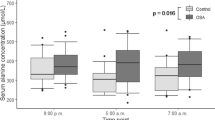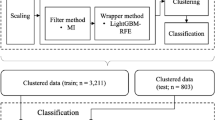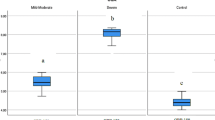Abstract
Obstructive sleep apnea (OSA) is a major public health problem affecting approximately 2% to 3% of children. However, snoring, the cardinal symptom of OSA, affects at least 5-fold more children, such that evaluation by overnight polysomnography (ONP) is required for the diagnosis. ONP is laborious, expensive, and relatively unavailable to children. Proteomic mass spectrometry coupled with bioinformatic tools provide valuable means for discovery of new biomarkers in serum for a variety of human disorders. The possibility exists that snoring children with and without OSA may exhibit different protein expression profiles in serum that could be useful in the development of novel diagnostic tools for this condition. The proteomic patterns of 20 children with OSA and of 20 children with habitual primary snoring but no evidence of OSA (HS) were evaluated using surface-enhanced laser desorption/ionization time-of-flight mass spectrometry (SELDI-TOF MS). Linear discriminative analysis identified three differentially regulated proteins with molecular masses of 5896, 3306, 6068 Da that were capable of diagnosing OSA with 93% sensitivity and 90% specificity. Thus, the proteomic signatures of sera from children with OSA differ from those of HS who do not fulfill the current criteria for treatment. Identification and sequencing of those differentially expressed proteins discovered through proteomic strategies may lead to future development of serum-based diagnostic tests for OSA in snoring children.
Similar content being viewed by others
Log in or create a free account to read this content
Gain free access to this article, as well as selected content from this journal and more on nature.com
or
Abbreviations
- AHI:
-
obstructive apnea/hypopnea index
- HS:
-
primary habitual snorers
- ONP:
-
overnight polysomnography
- OSA:
-
obstructive sleep apnea
- REM:
-
rapid eye movement
- SELDI-TOF MS:
-
surface-enhanced laser desorption/ionization time-of-flight mass spectrometry
- TST:
-
total sleep time
References
Ali NJ, Pitson DJ, Stradling JR 1993 Snoring, sleep disturbance, and behaviour in 4-5 year olds. Arch Dis Child 68: 360–366
Gislason T, Benediktsdottir B 1995 Snoring, apneic episodes, and nocturnal hypoxemia among children 6 months to 6 years old. An epidemiologic study of lower limit of prevalence. Chest 107: 963–966
Nieto FJ, Young TB, Lind BK, Shahar E, Samet JM, Redline S, D'Agostino RB, Newman AB, Lebowitz MD, Pickering TG 2000 Association of sleep-disordered breathing, sleep apnea, and hypertension in a large community-based study. Sleep Heart Health Study. JAMA 283: 1829–1836
Teculescu DB, Caillier I, Perrin P, Rebstock E, Rauch A 1992 Snoring in French preschool children. Pediatr Pulmonol 13: 239–244
Hultcrantz E, Lofstrand-Tidestrom B, Ahlquist-Rastad J 1995 The epidemiology of sleep related breathing disorder in children. Int J Pediatr Otorhinolaryngol 32( Suppl): S63–S66
Owen GO, Canter RJ, Robinson A 1996 Snoring, apnoea and ENT symptoms in the paediatric community. Clin Otolaryngology 21: 130–134
Ferreira AM, Clemente V, Gozal D, Gomes A, Pissarra C, Cesar H, Coelho I, Silva CF, Azevedo MH 2000 Snoring in Portuguese primary school children. Pediatrics 106: E64
O'Brien LM, Holbrook CR, Mervis CB, Klaus CJ, Bruner JL, Raffield TJ, Rutherford J, Mehl RC, Wang M, Tuell A, Hume BC, Gozal D 2003 Sleep and neurobehavioral characteristics of 5- to 7-year-old children with parentally reported symptoms of attention-deficit/hyperactivity disorder. Pediatrics 111: 554–563
Carroll JL, McColley SA, Marcus CL, Curtis S, Loughlin GM 1995 Inability of clinical history to distinguish primary snoring from obstructive sleep apnea syndrome in children. Chest 108: 610–618
Kang X, Xu Y, Wu X, Liang Y, Wang C, Guo J, Wang Y, Chen M, Wu D, Wang Y, Bi S, Qiu Y, Lu P, Cheng J, Xiao B, Hu L, Gao X, Liu J, Wang Y, Song Y, Zhang L, Suo F, Chen T, Huang Z, Zhao Y, Lu H, Pan C, Tang H 2005 Proteomic fingerprints for potential application to early diagnosis of severe acute respiratory syndrome. Clin Chem 51: 56–64
Li J, Zhang Z, Rosenzweig J, Wang YY, Chan DW 2002 Proteomics and bioinformatics approaches for identification of serum biomarkers to detect breast cancer. Clin Chem 48: 1296–1304
Merchant M, Weinberger SR 2000 Recent advancements in surface-enhanced laser desorption/ionization-time of flight-mass spectrometry. Electrophoresis 21: 1164–1177
Kuwata H, Yip TT, Yip CL, Tomita M, Hutchens TW 1998 Bactericidal domain of lactoferrin: detection, quantitation, and characterization of lactoferricin in serum by SELDI affinity mass spectrometry. Biochem Biophys Res Commun 245: 764–773
Qu Y, Adam BL, Yasui Y, Ward MD, Cazares LH, Schellhammer PF, Feng Z, Semmes OJ, Wright GL Jr 2002 Boosted decision tree analysis of surface-enhanced laser desorption/ionization mass spectral serum profiles discriminates prostate cancer from noncancer patients. Clin Chem 48: 1835–1843
Adam BL, Qu Y, Davis JW, Ward MD, Clements MA, Cazares LH, Semmes OJ, Schellhammer PF, Yasui Y, Feng Z, Wright GL Jr 2002 Serum protein fingerprinting coupled with a pattern-matching algorithm distinguishes prostate cancer from benign prostate hyperplasia and healthy men. Cancer Res 62: 3609–3614
Petricoin EF, Ardekani AM, Hitt BA, Levine PJ, Fusaro VA, Steinberg SM, Mills GB, Simone C, Fishman DA, Kohn EC, Liotta LA 2002 Use of proteomic patterns in serum to identify ovarian cancer. Lancet 359: 572–577
National Institutes of Health Rechtschaffen A, Kales AA (eds) 1968 A manual of standardized terminology, techniques and scoring systems for sleep stages of human subject. Government Printing Office, Washington DC, No. 204.
Marcus CL, Omlin KJ, Basinki DJ, Bailey SL, Rachal AB, Von Pechmann WS, Keens TG, Ward SL 1992 Normal polysomnographic values for children and adolescents. Am Rev Respir Dis 146: 1235–1239
1996 Standards and indications for cardiopulmonary sleep studies in children. American Thoracic Society. Am J Respir Crit Care Med 153: 866–878
1992 EEG arousals: scoring rules and examples: a preliminary report from the Sleep Disorders Atlas Task Force of the American Sleep Disorders Association. Sleep 15: 173–184
Mograss MA, Ducharme FM, Brouillette RT 1994 Movement/arousals. Description, classification, and relationship to sleep apnea in children. Am J Respir Crit Care Med 150: 1690–1696
Poser JW, Esch FS, Ling NC, Price PA 1980 Isolation and sequence of the vitamin K-dependent protein from human bone. Undercarboxylation of the first glutamic acid residue. J Biol Chem 255: 8685–8691
Section on Pediatric Pulmonology, Subcommittee on Obstructive Sleep Apnea Syndrome, American Academy of Pediatrics 2002 Clinical practice guideline: diagnosis and management of childhood obstructive sleep apnea syndrome. Pediatrics 109: 704–712
Paradis V, Degos F, Dargere D, Pham N, Belghiti J, Degott C, Janeau JL, Bezeaud A, Delforge D, Cubizolles M, Laurendeau I, Bedossa P 2005 Identification of a new marker of hepatocellular carcinoma by serum protein profiling of patients with chronic liver diseases. Hepatology 41: 40–47
Chen YD, Zheng S, Yu JK, Hu X 2004 Artificial neural networks analysis of surface-enhanced laser desorption/ionization mass spectra of serum protein pattern distinguishes colorectal cancer from healthy population. Clin Cancer Res 10: 8380–8385
Ebert MP, Meuer J, Wiemer JC, Schulz HU, Reymond MA, Traugott U, Malfertheiner P, Rocken C 2004 Identification of gastric cancer patients by serum protein profiling. J Proteome Res 3: 1261–1266
Becker S, Cazares LH, Watson P, Lynch H, Semmes OJ, Drake RR, Laronga C 2004 Surfaced-enhanced laser desorption/ionization time-of-flight (SELDI-TOF) differentiation of serum protein profiles of BRCA-1 and sporadic breast cancer. Ann Surg Oncol 11: 907–914
Li J, Zhang Z, Rosenzweig J, Wang YY, Chan DW 2002 Proteomics and bioinformatics approaches for identification of serum biomarkers to detect breast cancer. Clin Chem 48: 1296–1304
Bischoff R, Luider TM 2004 Methodological advances in the discovery of protein and peptide disease markers. J Chromatogr B Analyt Technol Biomed Life Sci 803: 27–40
Gozal D, Lipton AJ, Jones KL 2002 Circulating vascular endothelial growth factor levels in patients with obstructive sleep apnea. Sleep 25: 59–65
Cioffi M, Molinari AM, Gazzerro P, Di Finizio B, Fratta M, Deufemia A, Puca GA 1997 Serum osteocalcin in 1634 healthy children. Clin Chem 43: 543–545
Ambroszkiewicz J, Gajewska J, Laskowska-Klita T 2002 [Serum osteocalcin and bone alkaline phosphatase in healthy children in relation to age and gender]. Med Wieku Rozwoj 6: 257–265
Ferrari S, Zolezzi C, Pratelli L, Fasano MC, Bacci G 2003 Urinary excretion of pyridinium cross-links and serum osteocalcin levels in patients with primary high-grade osteosarcoma. Calcif Tissue Int 73: 1–4
Baskin E, Besbas N, Saatci U, Hascelik G, Topaloglu R, Ozen S, Bakkaloglu A 2004 Biochemical markers of bone turnover in the diagnosis of renal osteodystrophy in dialyzed children. Turk J Pediatr 46: 28–31
Leger J, Thizon de Gaulle I, Czernichow P 1993 Bone demineralization and elevation of serum osteocalcin concentrations in young children with hyperthyroidism. [Article in French]. Ann Pediatr (Paris) 40: 404–409
Takami H, Shikata J 1990 Serum bone Gla protein as an indicator of parathyroidectomy in patients with secondary hyperparathyroidism. World J Surg 14: 431–435
Meeran K, Hattersley A, Burrin J, Shiner R, Ibbertson K 1995 Oral and inhaled corticosteroids reduce bone formation as shown by plasma osteocalcin levels. Am J Respir Crit Care Med 151: 333–336
Colle M, Ruffie A, Ruedas E, Chebbo M 1987 Osteocalcin in children of short stature and its nocturnal variations. Arch Fr Pediatr 44: 839–841
Soultan Z, Wadowski S, Rao M, Kravath RE 1999 Effect of treating obstructive sleep apnea by tonsillectomy and/or adenoidectomy on obesity in children. Arch Pediatr Adolesc Med 153: 33–37
Marcus CL, Carroll JL, Koerner CB, Hamer A, Lutz J, Loughlin GM 1994 Determinants of growth in children with the obstructive sleep apnea syndrome. J Pediatr 125: 556–562
Bland RM, Bulgarelli S, Ventham JC, Jackson D, Reilly JJ, Paton JY 2001 Total energy expenditure in children with obstructive sleep apnoea syndrome. Eur Respir J 18: 164–169
Bar A, Tarasiuk A, Segev Y, Phillip M, Tal A 1999 The effect of adenotonsillectomy on serum insulin-like growth factor-I and growth in children with obstructive sleep apnea syndrome. J Pediatr 135: 76–80
Author information
Authors and Affiliations
Corresponding author
Additional information
This study was supported in part by National Institutes of Health grant HL 65270 and The Commonwealth of Kentucky Research Challenge Trust Fund.
Rights and permissions
About this article
Cite this article
Shah, Z., Jortani, S., Tauman, R. et al. Serum Proteomic Patterns Associated With Sleep-Disordered Breathing in Children. Pediatr Res 59, 466–470 (2006). https://doi.org/10.1203/01.pdr.0000198817.35627.fc
Received:
Accepted:
Issue date:
DOI: https://doi.org/10.1203/01.pdr.0000198817.35627.fc



